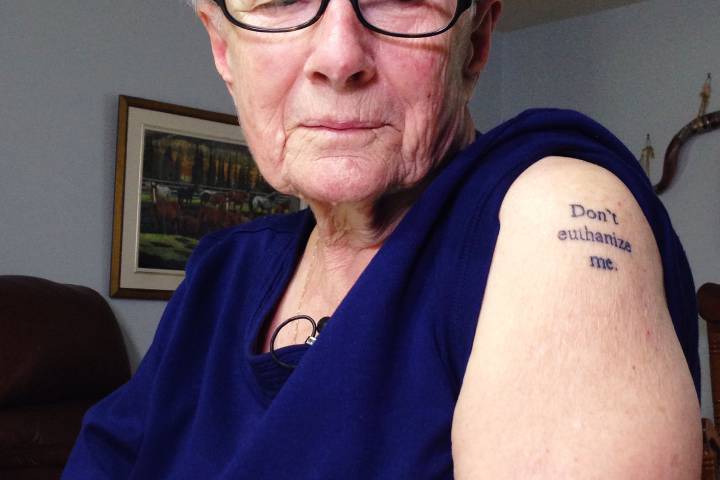By Jonathon Van Maren
Since June of this year, 384 Canadians were killed by assisted suicide. The Canadian government deliberately provided the poisons and paid for the physicians to administrate lethal injections for hundreds of people, but we seem to have gotten so used to the whole thing so quickly that I thought it might be time to see what’s really going on. Let’s take a look at just a few recent news articles, so that we can see where we are and get squinty look at where we’re headed.
On October 20, the National Post reported that Richard Brown, a 94-year-old widower living in Vancouver, was “sick and tired” and decided that he wanted to die. He related to his son that he had stashed away some of his deceased wife’s sedatives in order to kill himself. His son Jeremy Brown discovered that there were not enough of the pills to ensure death, and so, the Post relates, “the plan changed to assisted death.”
Despite the fact that Brown would not technically qualify under Canada’s euthanasia regime, and despite the fact that a number of his children were firmly opposed to assisted suicide for their father, Vancouver abortionist Ellen Wiebe agreed to stretch a few loopholes and get the job done. On Thanksgiving, Wiebe arrived at Brown’s home, had a cup of tea while she “prepared her syringes,” and then “administered the drugs, and he died.” As always, it seems, abortionists are on hand to offer death as the solution to life.
Later in October, the CBC published an article detailing the situation of Adam Maier-Clayton, a 27-year-old man from Windsor, Ontario. He “lives in constant pain, and wants to die.” According to the CBC:
The 27-year-old business school graduate has battled anxiety, mood disorder and obsessive compulsive disorder since he was a child.
He says his debilitating pain feels like parts of his body are being burned by acid. Despite a host of treatments, some of them experimental, his agony has only worsened in recent years.
Fed up with the torment, Maier-Clayton wants doctors to help him end his life. But Canada’s assisted dying laws, which came into effect last summer, do not apply to people with mental illness…
Maier-Clayton said the current law does not protect people like him.
Of course, the opposite is true. The law—for the moment—does protect people like Maier-Clayton, placing a legal barrier that once existed for all Canadians between a young man with mental illness and the ultimate self-harm: suicide.
We can only be relieved that thus far, Canada’s porous and feeble euthanasia laws have kept Maier-Clayton alive, as stories of those who were killed for the most trivial reasons—one woman may only have had a bladder infection—are already leaking out of Canadian hospitals. It is such cases that led an 81-year-old great-grandmother to have the sad plea “Don’t euthanize me” tattooed on her arm some time ago. “It’s drastic,” she said. “But life to me is so precious.”
Elderly people have a right to be nervous. Just last month, the Dutch government announced their intention to draft legislation that would permit those who felt they had “completed life” to kill themselves—and with government assistance, too. Of course, even now the soothing insidiousness of the suicide activists is intact—the Dutch health minister, Edith Schippers, assured the public that the new suicide freeway would be limited to the elderly. Respecting your elders, it seems, now means letting them know that they can kill themselves any day now. To any elderly men or women feeling depressed, or fatigued, or struggling with the reality of becoming old, the Dutch government has a message: Ready when you are.
Dutch assurances of the imminent installation of rickety guardrails to protect their citizens from the temptation of an easy death ring increasingly hollow with each passing month. Just this week, Marcel Langedijk of the Netherlands reported that his brother was killed after tiring of his struggle with alcoholism:
On the day of his death, he “laughed, drank, smoked, ate ham and cheese sandwiches and soup with meatballs” until his doctor arrived at his parents’ home at 3.15pm. His doctor explained the procedure, before telling Mr Landedijk to get into bed and to stay calm. At this point, they all “started crying, my parents, everyone actually, even Mark”.
“We cried, told each other that we loved each other, that it would be all right, that we would care for each other, that we would see each other again, we held each other,” he said. “If it was not so terrible, it would have been nice. Mark’s eyes turned away, he sighed deeply. His last. Dr Marijke injected the third syringe. His face changed, lost color. My little brother was dead.”
So that’s where all of this ends up. Already, apparently, we are sympathetic to killing old people because they are old and should be relieved of the burden of longevity. We’ll kill those with mental illness, because in this upside-down version of the world, death is treatment and to refuse a procedure once reserved for murderer-rapists to those suffering from depression is now unfair. Eventually, we’ll be offing alcoholics because they’re just so frustrated that the last stint in rehab didn’t do the trick. In fact, if we’re honest, there really won’t be any reasons we won’t kill people, because everyone is equal and once we declare something to be a right, we have legislated the premises needed for anyone to demand it.
I have only one question: Is it a failure on the part of the rest of society when Canadians struggling with severe difficulties in life would rather die than live?









I read this with such a heavy heart. How can anyone accept this? What happened to us humans?
People have to deal with the whole problem. We are Spirtual as well as Physical beings. If we don’t have a proper relationship with our Creator we can not expect wholeness or healing. Jesus says come to me you who are heavy laden and I will give you rest. It’s a promise from God to us, if we trust and believe him.
It’s sad that you would would prefer for someone to live with zero quality of life and suffer day in, day out. That’s truly the most evil torture I can think of. Be proud of yourself for condoning modern torture methods for the ill.
But is euthanasia the ONLY alternative Taryn? Many elderly people are extremely lonely. No doubt that would cause many to want to die. What if there were a way to ensure regular visits to every lonely senior? A huge task? Sure but certainly far better then killing them wouldn’t you say?
A few years ago in the UK there was a consenting scheme of ending life in hospitals called The Liverpool Pathway. However after several complaints rom relatives the government of the day ordered an investigation into how it was being implemented. It became obvious that it was being misused and used to clear hospital beds. Relatives were not being properly briefed on the scheme or in some cases consent obtained. The government immediately stopped the system.
Selected euthanasia is the thin edge of the wedge and the road to Hell is paved with good intentions. All life is precious and should where ever possible preserved. In the UK we have the best palliative (end of life) care. You don’t need euthanasia, just care for people better irrespective of their medical or mental condition even If it costs more.